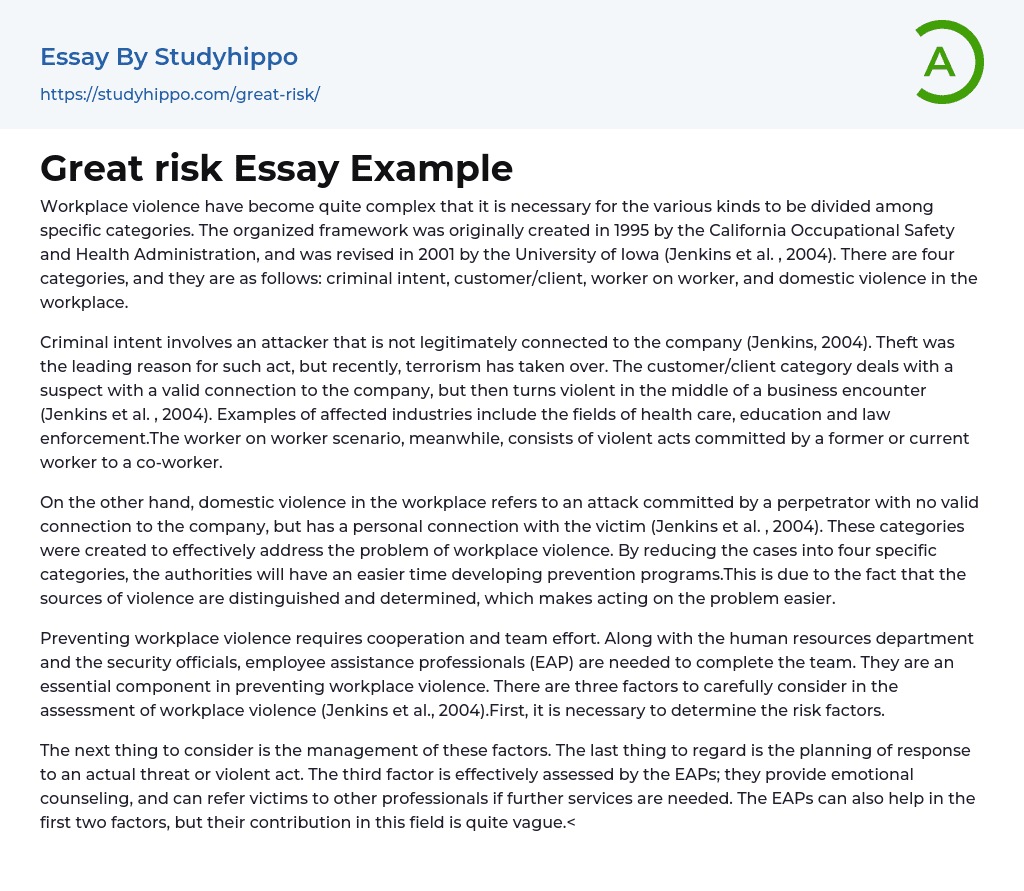Workplace violence have become quite complex that it is necessary for the various kinds to be divided among specific categories. The organized framework was originally created in 1995 by the California Occupational Safety and Health Administration, and was revised in 2001 by the University of Iowa (Jenkins et al. , 2004). There are four categories, and they are as follows: criminal intent, customer/client, worker on worker, and domestic violence in the workplace.
Criminal intent involves an attacker that is not legitimately connected to the company (Jenkins, 2004). Theft was the leading reason for such act, but recently, terrorism has taken over. The customer/client category deals with a suspect with a valid connection to the company, but then turns violent in the middle of a business encounter (Jenkins et al. , 2004). Examples of affected industries include the fields of health care, e
...ducation and law enforcement.The worker on worker scenario, meanwhile, consists of violent acts committed by a former or current worker to a co-worker.
On the other hand, domestic violence in the workplace refers to an attack committed by a perpetrator with no valid connection to the company, but has a personal connection with the victim (Jenkins et al. , 2004). These categories were created to effectively address the problem of workplace violence. By reducing the cases into four specific categories, the authorities will have an easier time developing prevention programs.This is due to the fact that the sources of violence are distinguished and determined, which makes acting on the problem easier.
Preventing workplace violence requires cooperation and team effort. Along with the human resources department and the security officials, employee assistance professionals (EAP) are neede
to complete the team. They are an essential component in preventing workplace violence. There are three factors to carefully consider in the assessment of workplace violence (Jenkins et al., 2004).First, it is necessary to determine the risk factors.
The next thing to consider is the management of these factors. The last thing to regard is the planning of response to an actual threat or violent act. The third factor is effectively assessed by the EAPs; they provide emotional counseling, and can refer victims to other professionals if further services are needed. The EAPs can also help in the first two factors, but their contribution in this field is quite vague.
An effective workplace violence prevention program starts with assessing the risks inherent in the workplace, and to discover the company's capacity to deal with the scenarios attributed to the risk factors (Jenkins et al. , 2004). There is a long list of risk factors to consider for workplace violence assessment. The initial risk factor is public contact. Whatever one's occupation might be, contact with other people is expected. Contact with strangers definitely has an inherent risk.
Another risk factor is working with unstable people.Health care providers and police officers have high risks for workplace violence because of the kind of people they deal with. Because of the unpredictability of the persons involved, it is probable that a violent act may ensue. Working on a graveyard schedule also puts one in a great risk.
These are only few of the many risk factors for workplace violence (Jenkins et al. , 2004). To properly determine the possibility of violence to occur in a certain work cite, it is
necessary that a system be developed for the documentation of violent occurrences.If there is a system that monitors violent instances within the workplace, there will data to be utilized in the assessment of the risk factors and the possible strategies to be used for it. Employee participation is of utmost importance. Survey through questionnaires are helpful to both parties; while the prevention teams can learn from the employees input to better their services, the employees in turn can experience the company's concern for their welfare (Jenkins, 2004).
- Auction essays
- Balanced Scorecard essays
- Business Plans essays
- Expense essays
- Income essays
- Net Income essays
- Security Guard essays
- Singapore Airlines essays
- Battle essays
- Intranet essays
- Maintenance essays
- Simulation essays
- Inn essays
- Animal Cruelty essays
- Law Enforcement essays
- Juvenile Justice System essays
- Surveillance essays
- Forensic Science essays
- Crime Prevention essays
- Criminal Justice essays
- Criminology essays
- Drug Trafficking essays
- Juvenile Delinquency essays
- Organized Crime essays
- Penology essays
- Prison essays
- Property Crime essays
- Punishment essays
- Serial Killer essays
- Sexual Offence essays
- Victim essays
- Crime scene essays
- Punishments essays
- Charles Manson essays
- Juvenile Crime essays
- Piracy essays
- Stealing essays
- Gang essays
- Hate Crime essays
- Homicide essays
- Damages essays
- Murder essays
- Robbery essays
- Ted Bundy essays
- Prostitution essays
- Violent crime essays
- Rape essays
- Identity Theft essays
- Sexual Harassment essays
- Distracted Driving essays




